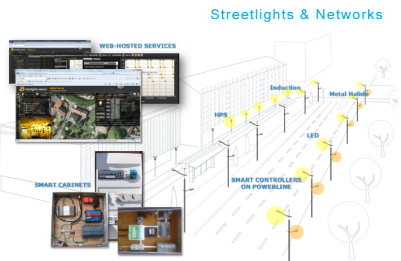Streetlight Technology Overview 
Solar street lights have been available for several years now; having originally been designed for use in less developed or isolated areas, or perhaps places where the electricity supply has been disrupted by man-made or natural disasters. The technology guiding the use of solar energy has progressed significantly to enable projects to be feasible throughout the world and in particular commercially viable grid connected solar street lighting. The situation now is that grid connected solar streetlights are mini-power generators exporting energy to the grid not powering the lamps. Designed to be simply and rapidly installed as a microgrid, giving the potential of many years of trustworthy use, with a minimum (near zero) maintenance required. In these times of heightened environmental awareness, electric street lighting is rightly regarded as an enormous consumer of electricity, at a vast financial and environmental cost. However, because of the road safety and security benefits that result from a managed street lighting system, authorities everywhere are looking to implement cost-effective and environmentally friendly lights. Solar street lights can deliver that much-desired outcome and offer an exceptional lighting program whilst, at the same time, producing considerable economic and environmental savings. However, it must be stressed that although solar street lighting, in a well-designed network, can bring significant benefits, nevertheless when using battery systems it is imperative that those lights that are chosen are completely appropriate for the specific environment and implementation. For battery systems It is not possible to buy ‘one size fits all’ or ‘straight from the shelf’ solar street lights systems. Careful consideration has to be given, for example, to the kind of solar panels to be employed; the lamps or LEDs, notwithstanding the non-proprietary architecture to integrate with all industry-standard electronic ballasts and light point controllers. The most recent developments with regard to the technology behind solar street lighting have been in LEDs. Firstly, LEDs consume far less power than the older type of conventional sodium lamp, though induction lamps have proven quite effective. LEDs have a much longer working life, better colour definition and require smaller solar components than sodium lamps. It can be appreciated, therefore, that, in order for solar streetlights technology to be efficient and cost-effective, a thorough and meticulous assessment has to be carried out, paying the utmost regard to information concerning solar radiation, the amount of sunshine prevalent and general climatic conditions in the relevant area. For battery powered solar streetlights: This needs to be done hand-in-hand with careful consideration of the exact requirements of the street lighting system, i.e. the number of hours of illumination required on a daily basis and other important data has to be precisely determined in order to provide the client with the system that will meet all those criteria. Unlike battery-powered solar streetlight our ‘microinverter grid-connected streetlight’ removes all the above items, as we are not powering the lamps. Instead we feed power into the grid during the daylight at maximum capacity generation. At night, the streetlights will continue to draw power from the grid under pre-program control as per on-demand lighting schedule, however with the objective in using less power than exported to the grid. On balance, generate more - use less. Equates to free electricity, the driving benefit, when combined with the element of management and control the streetlight network delivers a Value Proposition that’s compelling in the deployment of “Smart Grid Ready” digital green cities and municipalities with up to 50% energy and CO2 savings on your streetlight network. With this architecture you are able to deploy an efficient, reliable, economically sound, purpose-built “non-proprietary” solar street lighting network.  Solar street lighting can be used not only on streets, walkways and highways but can also provide cost-effective, environmentally friendly lighting for both military and civilian security installations; park areas or parking spaces; airports, docks and similar areas or, indeed, for whole communities. Neither are solar streetlights the only outlet for ‘grid-connect’ solar technology on the roads. Increasingly, traffic management systems such as traffic lights, road markers, traffic signs and bus shelters are employing solar technology because of their minimal running costs and low maintenance. Similarly, airports are becoming more aware of the benefits of solar lighting, even on runways. For environmentally and cost conscious solutions, solar streetlight micro-generation is the ideal method to illuminate the way ahead. |